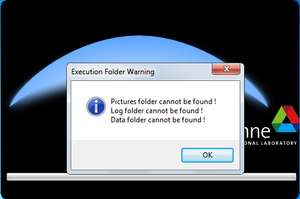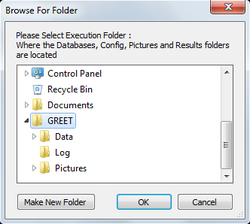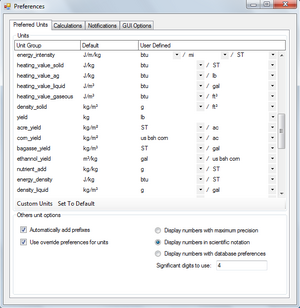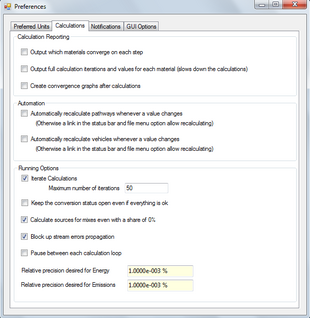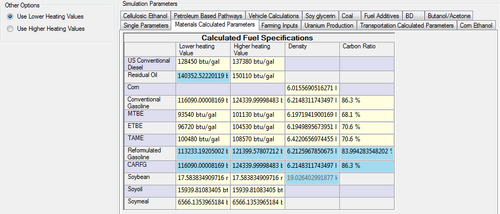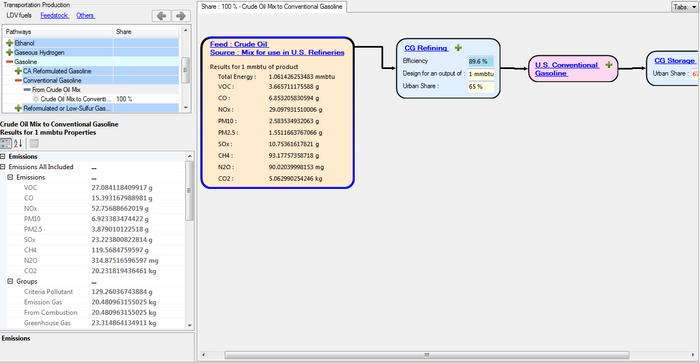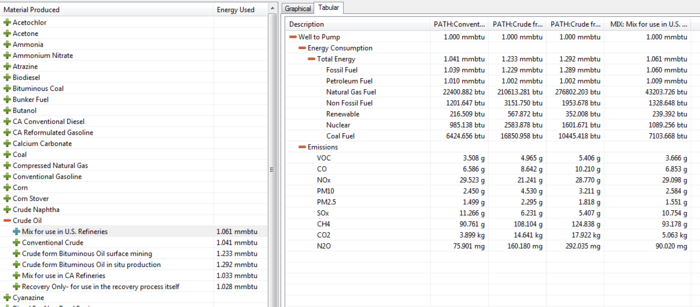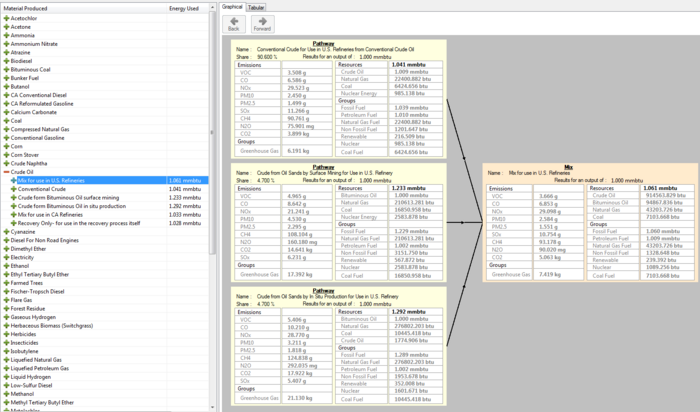Quick start guide: Difference between revisions
| Line 65: | Line 65: | ||
===Well to Pump Results=== | ===Well to Pump Results=== | ||
The well to pump results | The well to pump results allow viewing the combined results of each of the pathways in a mix and the cumulative energy usage and emissions for the LDV fuel. | ||
[[File:WellToPumpResultsTabular.png|thumb|none|700px|Well to pump results in table format]] | [[File:WellToPumpResultsTabular.png|thumb|none|700px|Well to pump results in table format]] | ||
The tabular version of the results displays the energy usage and emissions for each pathway as well as the weighted average of the values based on the share of each pathway. The pathways that are displayed depends on what is selected on the left material selection control. If the resulting material is selected then each pathway within each mix is displayed on the right as well as the weighted results for the mix. The column header represents this by starting with either "PATH" for pathway results or "SRC" for the mix results. Selecting a single pathway will display the energy used and emissions for each process within the pathway each denoted by "PROC" in the result table. The results can be exported by right clicking and selecting "Copy to Clipboard" or "Save to XML File". Once copied the results can either be pasted into Excel or a text editor. | |||
[[File:WellToPumpResultsGraphical.png|thumb|none|700px|Well to pump results in graphical format]] | [[File:WellToPumpResultsGraphical.png|thumb|none|700px|Well to pump results in graphical format]] | ||
Revision as of 19:23, November 22, 2011
How to Install and Run GREET
Running GREET
To run GREET simply run the GREET executable file from a file browser or a shortcut. Running the executable will open the program and allow loading GREET project files. To gain easier access right click the executable and go to send to and then select Desktop (create shortcut).
Selecting Working Folder
The processing and data files are separated to allow easily loading and saving multiple project files. After running GREET for the first time you will be asked to select the folder where these data files are stored.
After selecting OK on the message a window will open for selecting the location of the data folders. Navigate to where the "Pictures","Log", and "Data" folders are on your system and select the folder directly above these folders then select OK. The program will load the data files and display the graphical user interface (GUI).
Copying/Moving Data Folders
To copy the data folders to a new directory select copy on the directory containing the "Data", "Log", and "Pictures" folders and paste it to a new location. This allows customizing where on the computer the program/data is stored. The executable can be moved but be aware that any setting changes will be lost and you will have to specify the working folder again.
Using the GUI
The GUI separates the key points of setting parameters and viewing results into various controls accessible through the buttons at the top of the main GUI window.
This image shows the main navigation of the program. Each of the main views can be selected by clicking one of the large buttons on the step bar. In the toolbar the "File" dropdown exposes options for loading and saving GREET projects. The "Results" dropdown shows options for manually recalculating the results and monitoring values. From the "Preferences" dropdown the preferences window can be shown and the table editor can be opened. From the "About" dropdown database information can be viewed, the software can be updated, and the help pages can be opened.
Preferences
The main preference pages are the unit and calculation preferences accessible through their associated tabs within the preference window. The unit page, visible below, allows selecting desired units for various groups. Changing the value in the User defined column will cause values of that unit group to be displayed with the selected unit. If a group is made up of multiple units groups then the units can be changed within each group. An example of this is the first unit in the image below where Energy Intensity is composed of Energy over Distance over Mass.
The calculations tab provides various options for controlling how the calculations are executed and displayed. The "Running Options" group of options allows changing calculation parameters such as the maximum iterations to run for calculating upstream values.
Main views
This image shows the main views, mousing over a button will display the text as shown or displaying the images can be disabled from the preferences.
Basic Parameter Setup
This control allows modifying many of the simulation parameters within various tables such as which year to simulate. The tables have a title explaining more about what the table is used for and the cells display the various values. A light blue cell indicates that the value comes from a formula referencing other table values which can be viewed or modified by right clicking and selecting "Edit Formula". Each value stores a default number and an current number which can be swapped by selecting "Switch to default value" and "Switch to user value" from the right click menu. This allows making changes and easily returning to a default value. For most cells the value has an associated unit which can be modified from the right click menu by selecting "Change Unit" and then selecting the desired units.
Well to Pump Setup
This allows viewing and modifying parameters specific to processes as well as pathways.
Pathway Selection
The tree selection in the top left allows selecting a pathway which are organized into light duty vehicle (LDV) fuels, feedstocks, and others. Fuels that make up a family of actual fuels are denoted by a lighter teal color such as Diesel and Gasoline which have multiple fuels under those names. Under each fuel are mixes which represent a particular blend of fuels. Under each mix is one or more pathways which output a fuel that goes into the mix and next to it is the share that the fuel contributes to the mix.
Pathway Representation
The large panel on the right with boxes is a graphical representation of the selected pathway. If the pathway has a fuel that feeds into it then the feed panel will be on the left denoted by a light orange background. After the calculations have been run this panel displays a summary of energy and emissions for the feed mix when the mouse is moved over it. Clicking the title link will display the feed pathway and the back button on the pathway selection control allows returning to the previous pathway.
To the right of the feed are the processes with Stationary Processes showing with a light blue background and Transportation Processes with a pink background. Double clicking a Stationary Process expands the process to display the process fuels consumed in the process and if a fuel has technologies associated with it then it can be expanded to view the technologies. Double clicking a transportation process expands the process to display a graphical representation of the locations and modes that represent the transporting of the material to the destination. Double upward arrows next to a process represent a loss (leakage or boil-off) which can be displayed by clicking the arrows. Various parameters can be set for each process and the titles in blue can be used to open a window with more parameters for that object.
Property Display
The bottom left control displays properties for the selected object in the pathway representation. The pathway summary can also be display by clicking the "Switch to pathway" button. The emissions section displays how much of each gas emission is released and is also broke down intro all included and partial upstream. The emissions are also displayed in the groups criteria pollutants, emission gases, from combustion, and greenhouse gases. The energy is also broke down into upstream included and partial upstream as well as displaying energy per process fuel. The energy is also grouped into fossil, petroleum, natural gas, coal, non fossil, nuclear, and renewable fuels. If a loss is as is associated with the selected process then it will display in the losses section.
Well to Pump Results
The well to pump results allow viewing the combined results of each of the pathways in a mix and the cumulative energy usage and emissions for the LDV fuel.
The tabular version of the results displays the energy usage and emissions for each pathway as well as the weighted average of the values based on the share of each pathway. The pathways that are displayed depends on what is selected on the left material selection control. If the resulting material is selected then each pathway within each mix is displayed on the right as well as the weighted results for the mix. The column header represents this by starting with either "PATH" for pathway results or "SRC" for the mix results. Selecting a single pathway will display the energy used and emissions for each process within the pathway each denoted by "PROC" in the result table. The results can be exported by right clicking and selecting "Copy to Clipboard" or "Save to XML File". Once copied the results can either be pasted into Excel or a text editor.
